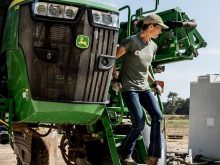Farmers love straight lines. Straight lines look sharp and mean you are on top of your game. Look anywhere and you will find them.
Drive down any Prairie road and look down a line of grain bins and good luck trying to find one out of step. This is civil engineering perfection, Prairie farm-style. If those bins were Olympic sprinters, eight gold medals would be needed.
There is rhyme and reason to storing farm machinery too. The brainy equipment with batteries and steering wheels and electronics gets to stay inside a shed. The brawny equipment with hitches and wings and shovels is lined up outside along a road or trail or bush or treeline, ready, waiting, to be hooked up and, like military, drawn away into battle.
Read Also

Gentle treatments for pain in the neck
Heading toward year-end, people unknowingly tense up against the cold and busyness, causing neck pain that can often be treated with appropriate support and gentle mobility, athletic therapist Kathlyn Hossack says.
Field work is the apex of straight line statesmanship. A spring field with long, straight furrows after seeding is to be admired and complimented. Especially after the grain sprouts green and lush, ready for the long haul journey to the bin. Darn it when a line gets plugged or a strip is made. Your farmer sense, like Spiderman, tells you something is out of place.
Fast-forward to harvest, and windrows laid straight and true are a thing of beauty. The rural equivalent of well-planned city streets, straight windrows are perfect for idle kids to challenge each other to 100-yard hurdle races.
And so, farm kids have to live up to the standard. Farm kids know the feeling and the pressure felt when farm dads lean over in the cab, go over the cultivator hydraulics one more time, tell you to pick out a marker on the other side of the field, and close the tractor door with a “keep it straight.”
And for the rest of the day, you try to straighten out the curve you’ve created, by overlapping a little more here and a little less there, before your dad returns over the hill to check up and see how you are doing. At the end of the day, when dads come to pick you up, they still pat you on the back, because they were there once too.
And so, 20-foot cultivators became 20-foot drills and 20-foot swathers. And if you had the gift of internal GPS, you were perfect every time. This was especially impressive during swathing. Farmers with the gift could eat a sandwich, scope out the neighbour’s field and pay attention to the radio, all at once. And when they were done, the field was so straight, a 747 could take off from it.
For mere farm mortals, doing all three of those things may have sent the swather heading in the opposite direction. Alas, I can remember only a few fields I swathed that were brag-worthy.
In the end, ask any farmer what is really important, and he or she will not say it is straight lines. It’s not a straight row of bins or a straight swath or a perfect-looking, freshly seeded field that is three weeks old. Nope. A farmer will say what’s really important is the farm year has come and gone, the bins are full enough, and all hands can do it again next year.
– Brad Hauber is a writer based in Saskatchewan. He still returns to the farm and tries to make straight lines.














